From FishEaters Website
Michaelmas
Embertide
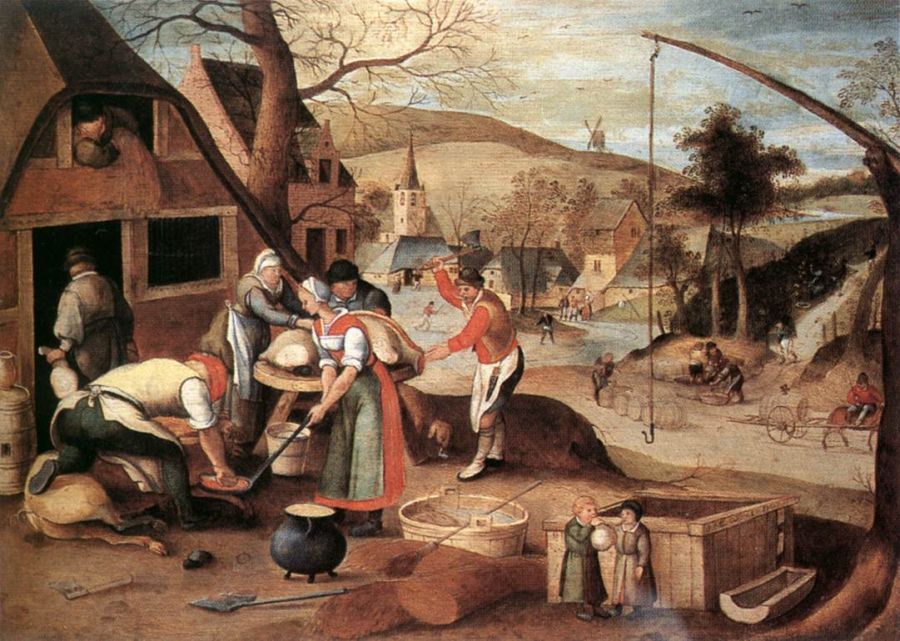
Wednesday, Friday, and Saturday after the the Feast of the Exaltation of the Holy Cross, 14 September, 1 are known as "Michaelmas Embertide," and they come near the beginning of Autumn (September, October, November). The Lessons focus on the Old Covenant's Day of Atonement and the fast of the seventh month, but start off with this prophecy from Amos 9:13-15:
Behold the days come, when the ploughman shall overtake the reaper, and the treader of grapes him that soweth seed, and the mountains shall dop sweetness, and every hill shall be tilled. And I will bring back the captivity of My people Israel, and they shall build the abandoned cities, and inhabit them; and they shall plant vineyards, and drink the wine of them; and shall make gardens and eat the fruits of them; and I will plant them upon their land: and I will no more pluck them out of their land which I have given them; saith the Lord thy God.
Like all Embertides but Whit Embertide, the Lessons end with the story of the three boys in the fiery furnace, as told by Daniel.
The Gospel readings recount how Jesus exorcised demons from a possessed boy and tells the disciples about fasting to cast out unclean spirits (Matthew 9:16-28), forgave Mary Magdalen (Luke 7:36-50), and healed the woman on the sabbath after telling the parable of the fig tree (Luke 13:6-17).
The Natural Season
Psalm 144:15-16
"The eyes of all hope in thee, O Lord:
and thou givest them meat in due season.
Thou openest thy hand,
and fillest with blessing every living creature."
Oh, delicious Autumn! Trees lavish with spice colors... the earthy smell of their leaves burning in hypnotic flames... the rich colors of grapes, apples, pumpkin, and squash, of gold and scarlet flowers... the invigorating air inviting warm sweaters... The season is marked by a bounty that lends itself well to some wonderful holidays, especially Martinmas and the secular American and Canadian Thanksgivings (the fourth Thursday in November and October 2, respectively). This delightful poem, written in an old Hoosier dialect by James Whitcomb Riley (October 7, 1849 - July 22, 1916), conveys the feeling of Autumn so well:
When the Frost is on the Pumpkin
When the frost is on the punkin and the fodder's in the shock,
And you hear the kyouck and gobble of the struttin' turkey-cock,
And the clackin' of the guineys, and the cluckin' of the hens,
And the rooster's hallylooyer as he tiptoes on the fence;
O, it's then's the times a feller is a-feelin' at his best,
With the risin' sun to greet him from a night of peaceful rest,
As he leaves the house, bare-headed, and goes out to feed the stock,
When the frost is on the punkin and the fodder's in the shock.
They's something kindo' harty-like about the atmusfere
When the heat of summer's over and the coolin' fall is here
Of course we miss the flowers, and the blossums on the trees,
And the mumble of the hummin'-birds and buzzin' of the bees;
But the air's so appetizin'; and the landscape through the haze
Of a crisp and sunny morning of the airly autumn days
Is a pitcur' that no painter has the colorin' to mock
When the frost is on the punkin and the fodder's in the shock.
The husky, rusty russel of the tossels of the corn,
And the raspin' of the tangled leaves, as golden as the morn;
The stubble in the furries --kindo' lonesome-like, but still
A-preachin' sermuns to us of the barns they growed to fill;
The strawstack in the medder, and the reaper in the shed;
The hosses in theyr stalls below -- the clover overhead!
O, it sets my hart a-clickin' like the tickin' of a clock,
When the frost is on the punkin and the fodder's in the shock!
Then your apples all is getherd, and the ones a feller keeps
Is poured around the cellar-floor in red and yeller heaps;
And your cider-makin' 's over, and your wimmern-folks is through
With their mince and apple-butter, and theyr souse and sausage, too!
I don't know how to tell it -- but ef sich a thing could be
As the Angels wantin' boardin', and they'd call around on me
I'd want to 'commondate 'em -- all the whole-indurin' flock --
When the frost is on the punkin and the fodder's in the shock!
In the midst of this beautiful time, things wizen and seem to begin to die. The air grows cooler, the earth stiffens, the trees tire of holding their leaves. And during this waning we remember our dead -- on 1 November, the victorious dead (All Saints, or All Hallows Day), and on 2 November, the dead being purified (All Souls Day). These Days of the Dead begin with the eve of All Hallows, or "Hallowe'en," an unofficial evening of remembering the frightening fate of the damned and how we can avoid it. There can't be a more appropriate time for such a night than Autumn, when foggy mists are likely, and bonfires helpful.
Associations
and Symbols
Autumn is characterized by "dry and cold," and is associated with maturity, the humour of black bile, the melancholic temperament, 2 and the element of earth. Giuseppe Arcimboldo's fascinating portraits of the season and its associated element lead the imagination in all directions:
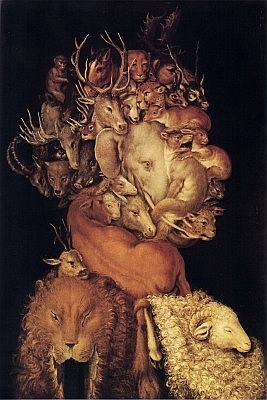
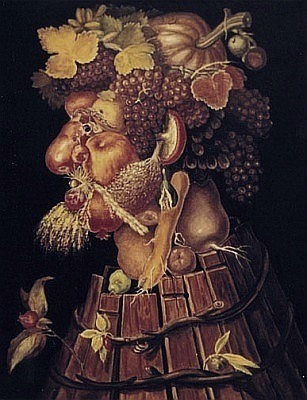
Get your children to think of what changes atmospherically and astronomically during the this season. Why is it getting colder? How does the cooling affect the earth's air and waters? Remember that lore says that the weather conditions of each of the three days of an Embertide foretell the weather of the next three months, so the weather seen on Wednesday of Michaelmas Embertide predicts the weather of the coming October, Friday's weather foretells the weather of November, and Saturday's weather foretells the weather of December. Make a note of the weather on those three days and see if the old tales are true!
What stars can be seen during the Autumn months? Do your children know the traditional names for this season's full Moons?:
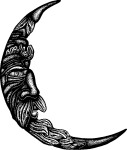
September Harvest Moon
October Hunter's Moon
November Beaver Moon
If they were in charge of naming the Moons of this season, what would they call them?
Ask your children to consider how the seasonal changes affect the plants and animals. How are the trees changing? What are the animals doing now? Are any animals migrating before the Winter storms come? Are any storing up food to eat during the cold months? Which have fur that is growing thicker to protect them?
Ask them to consider how the seasonal changes of Autumn affect (or traditionally affected) the activities of man. What can we do now that we couldn't do at other times of the year? What can't we do? How do modern conveniences affect the answers to those questions? Ask them how they would ensure they had shelter, food, and water if they were put into the middle of the woods right now, with the season as it is. What plants and animals would be available to eat? How would they keep themselves dry and warm and protected from the sun and insects?
In the Middle Ages, the months are almost always uniformly depicted by showing the "Labours of Man" throughout the seasons. In stained glass windows, in illuminated manuscripts, one sees over and over the same human activities used to portray the months. Below are the months of September, October, and November from the "Très Belles Heures" by the brothers Jean, Paul, and Hermann Limbourg, the same men who illuminated the "Très Riches Heures du Duc de Berry." Click on each picture to see how that month is portrayed in the that latter work:
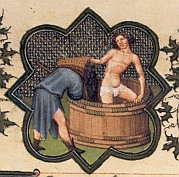
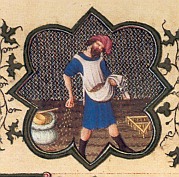
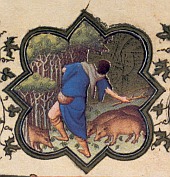
September making wine
October sowing
November knocking acorns down
from the trees for the animals


In addition to these things, now is the time to plant trees (early Fall or early Spring), go hunting, have weenie roasts, chop wood (especially hard woods like oak or walnut) so it can season for a year for use during next year's Winter, make a scarecrow, make apple dolls, make pumpkin bread (to eat after the Embertide fast), and, most of all, praise God for His artistry and providence... Get to it!
-- and know that just when you tire of this season, Winter will be here!
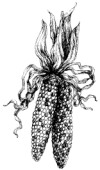
See also Advent Embertide (Winter), Lenten Embertide (Spring), and Whit Embertide (Summer). Read also about Rogation Days if you are tempted to inordinately sentimentalize nature.
Footnote:
1 Note that these September Ember Days must follow a full week after Holy Cross Day (14 September).

2 Check here to learn about the theory of the Four Temperaments and to take a test to determine what your temperament is.

To read about the Ember Days of all for seasons, click here.
No comments:
Post a Comment
Comments are subject to deletion if they are not germane. I have no problem with a bit of colourful language, but blasphemy or depraved profanity will not be allowed. Attacks on the Catholic Faith will not be tolerated. Comments will be deleted that are republican (Yanks! Note the lower case 'r'!), attacks on the legitimacy of Pope Francis as the Vicar of Christ (I know he's a material heretic and a Protector of Perverts, and I definitely want him gone yesterday! However, he is Pope, and I pray for him every day.), the legitimacy of the House of Windsor or of the claims of the Elder Line of the House of France, or attacks on the legitimacy of any of the currently ruling Houses of Europe.